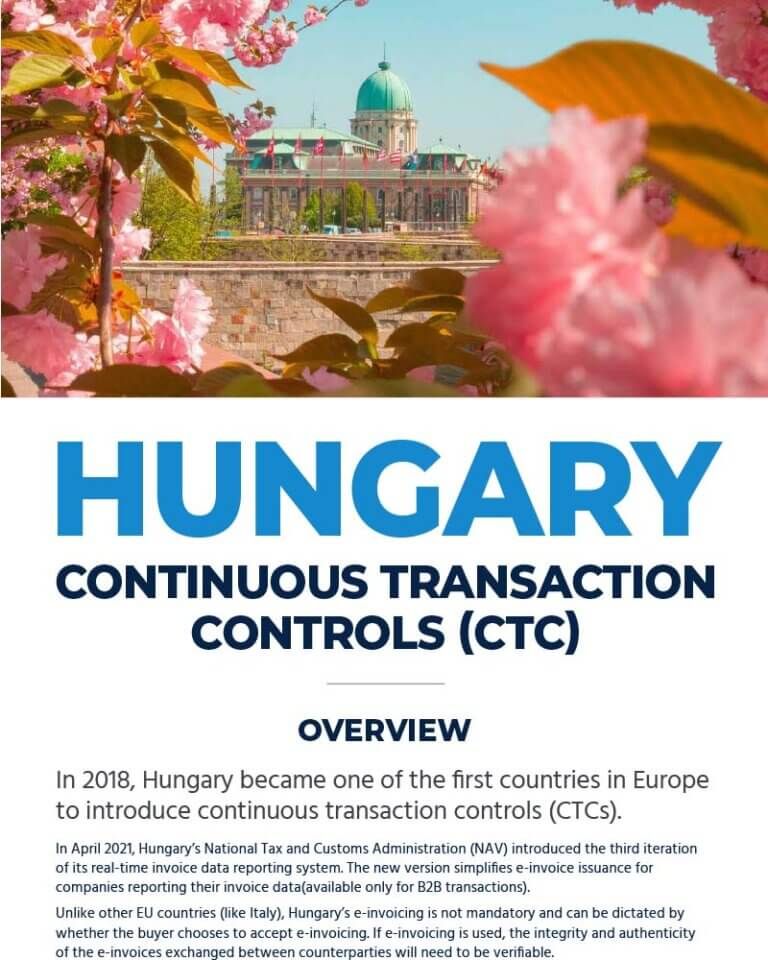Electronic invoicing in Colombia
Electronic invoicing in Colombia, often referred to as Colombia facturacion electronica, is mandated for established taxpayers. While it was an early mover in giving legal weight to e-invoices, Colombia’s mandate only came into effect in 2019 and has been subject to change since.
Understanding the specificities of the rules of overall tax compliance is vital. That’s why Sovos’ regulatory experts have produced this complete overview of Colombia e-invoicing. Bookmark this page to stay up to date with the latest requirements.
Table of contents
1. Characteristics of electronic invoicing in Colombia
2. Electronic invoicing law in Colombia
3. How does an e-invoice work in Colombia
4. Benefits of using e-invoicing in Colombia
5. Timeline of e-invoicing in Colombia
6. Penalties: What happens if I don’t comply to e-invoicing in Colombia?
7. How to choose the right e-invoicing software in Colombia?
Colombia B2B e-invoicing
All companies are required to issue electronic sales invoices with prior validation before issuance. Companies must enable themselves as electronic issuers through the web portal assigned by the DIAN.
Suppliers must also certify as Technology Services Providers (PST) and receive a unique software identifier. The standard format used is XML, following the UBL V2.1 (Universal Business Language) adopted by the DIAN.
A digital signature is mandatory to ensure authenticity and integrity throughout the invoicing process.
Invoices must use a consecutive numbering system assigned by the DIAN, along with a Unique Electronic Invoice Code (CUFE) for identification and data integrity. Issuers must create a graphic representation of the invoice in PDF format, including a QR code.
Both issuers and recipients must archive invoices for the period established by the tax statute.
Colombia B2G e-invoicing
Starting in November 2020, electronic invoicing became mandatory for all taxpayers – including B2G transactions. All suppliers must issue electronic invoices and buyers are required to receive them. Buyers do not need to validate the invoice, but they can accept or reject it.
Electronic invoices (Facturas electrónicas)
The electronic invoice is the evolution of the traditional invoice. It has the same validity as paper in a legal sense, but it is generated, validated, issued, received, rejected and preserved electronically. In tax terms, it supports sales transactions of goods and/or services.
All electronic sales invoices for tax recognition must be validated prior to their issuance by the Special Administrative Unit of the National Tax and Customs Directorate (DIAN).
The electronic sales invoice will only be classed as issued when it is validated and delivered to the purchaser – providing it also complies with the conditions, terms and technical and technological mechanisms established by the DIAN.
Electronic equivalent documents (Documentos equivalentes electrónicos)
In the context of electronic invoicing in Colombia, equivalent documents are digital receipts issued by the DIAN (National Tax and Customs Directorate) for transactions that do not require a sales invoice.
The Electronic Equivalent Document is defined as a document that:
- Contains the information of a commercial operation carried out by a subject that is not required to issue an electronic invoice
- Complies with legal requirements
- Is generated and transferred electronically through a technology provider authorised by the DIAN
Adjustment notes are included for the electronic equivalent document and have been created as a mechanism for their cancellation or correction.
Electronic sales receipt
An electronic sales receipt is a receipt that is issued to final consumers. It does not generate tax credit and its structure is less complex than electronic invoices.
Electronic debit and credit notes
Credit and debit notes are documents that allow adjustments or corrections to be made to electronic invoices. They must be generated and transmitted electronically to the DIAN for validation.
Document for payments in favour of non-VAT responsible
This document is a type of invoice that must be issued by the buyer when purchasing goods or services from persons not responsible for VAT.
Export and import electronic invoice
These documents must be issued to support export and import operations, in addition to other documents related to customs operations.
Other documents
Other related documents include those supporting expenses, deductions and other types of electronic media that facilitate compliance with tax obligations.
Electronic invoicing law in Colombia
Electronic Invoicing is mandatory in Colombia for businesses that are registered for Value Added Tax (VAT).
The mandate follows a pre-clearance model which came into effect in January 2019, starting with large taxpayers. It became mandatory for all taxpayers as of November 2020, covering B2G, B2B and B2C transactions.
Colombia requires suppliers to issue e-invoices and buyers have to either accept or reject them, though they do not need to validate the document. DIAN, the country’s tax authority, must clear the electronic invoices before they can be sent to the buyer – without clearance, the receipt cannot be issued and the goods cannot be shipped.
For more specifics on Colombia facturacion electronica (e-invoicing), read on.
Types of Operations Subject to the Colombian Electronic Invoice Regime
The electronic invoicing mandate in Colombia applies to the following documents and transactions:
Electronic invoices: Required in B2B transactions and when generating tax credit. The validity of this document is subject to strict compliance rules covering structure, issuance and validation.
Electronic equivalent documents: The following are currently considered equivalent to electronic invoices:
- Tickets for cash registers with POS systems
- Cinema admission tickets
- Passenger transport tickets
- Extracts issued by financial and similar institutions for financing operations
- Air transport tickets
- Documents in localized games of slots, bingo, casinos and the like
- The ballot, fraction, cardboard, forms or the like in games of luck or chance
- Documents issued in the collection of tolls
- Settlement receipts issued by the Colombian Stock Exchange
- The document of operations of the agricultural exchange and other commodities
- Documents issued for home public services
- Income tickets for public shows
Electronic sales ticket: The voucher issued to final consumers. It does not generate tax credit and its structure is less complex than electronic invoices.
Electronic debit and credit notes: Issued by the seller to recover expenses or accredit cancellations, discounts or other modifications to issued electronic invoices and tickets. Like electronic invoices, such notes must be pre-validated.
Document for payments in favour of the non-VAT-responsible: A type of invoice that must be issued by the buyer when purchasing goods or services from people not responsible for VAT.
Receipt for work income: Must be issued according to the format established in the technical documents of the electronic invoice when disbursements related to the taxpayer’s payroll are made, including parafiscal and social security contributions.
Electronic export and import invoice: Must be issued to support export and import operations, in addition to other documents related to customs operations. So far, only electronic export invoices have been developed and put into production.
Other documents: Expense support documents, deductions and other types of electronic media that facilitate compliance with tax obligations.
XML schema based on UBL 2.1
The standard e-invoicing format for e-invoices in Colombia is XML. This format follows Universal Business Language (UBL) V2.1.
The XML document is generated, comprised of the information that Colombia’s tax authority requires, and then signed with a digital certificate. From there, the taxpayer’s certified software validates the data, as well as both the issuer and recipient, and reports the transaction to the DIAN.
The tax authority will then record the document, assign a unique e-invoice number, notify the issuer that it has been processed successfully and deliver the XML to the issuer.
Unique electronic invoice code - CUFE
The Clave Única de Facturación (CUFE) code enables electronic invoices to be identified unequivocally. It’s also known simply as a unique electronic invoice code and is comprised of data from an invoice and the Technical Control Content Key provided by the tax authority.
The CUFE code also ensures the integrity of documents by using SHA384 encryption.
QR code
As well as being in the XML format with a digital signature and unique e-invoice code (CUFE), valid e-invoices in Colombia must include a QR code. This is mandated by law and is possible via certified technology providers like Sovos.
For customers who cannot receive electronic invoices, they are sent a QR Code invoice for the transaction.
Electronic container
One of the changes in Resolution 000012 saw the DIAN modify the e-invoicing law to implement the use of the electronic container. The electronic container is a mandatory electronic instrument used to include the information of the electronic sales invoice, debit notes, credit notes and general electronic information derived from the systems of billing – along with the validation carried out by the DIAN where applicable.
This modification means that e-invoices must utilise digital signatures to guarantee the authenticity and integrity of the document. The issuer must digitally sign the invoice to the standards laid out by the regulation and the tax authority’s signature policy.
How does an e-invoice work in Colombia?
Colombia’s electronic invoicing system contains multiple processes that the electronic biller, the DIAN, the technology providers and the electronic receivers or purchasers participate in.
Once the electronic biller complies with the authorisation requirements, they can start generating electronic invoices and equivalent documents.
Among the most important processes of this generation system are the following:
Validation: Colombia’s current electronic invoicing system requires invoices, and other documents issued by the person responsible for electronic invoicing, to be validated by the DIAN before being issued to their recipient.
Once this process is completed, the DIAN will proceed to register the electronic document in its databases with the value “document validated by the DIAN” while generating, signing, storing and sending a validation message to the electronic biller for its issuance and delivery to the acquirer.
Receipt of electronic documents: Electronic billers must also act as electronic receivers. To do this, they must establish an email to receive electronic sales invoices issued by their suppliers and other documents subject to the electronic invoice mandate.
This obligation is fulfilled by issuing an acknowledgement of receipt by the recipient and should only be done when the document issued has been validated by the DIAN. From a commercial point of view, if the recipient of the document agrees with the document received then they must formally accept it.
If the document does not comply with the commercial conditions agreed with the supplier, they must commercially reject the document and the associated acknowledgement of receipt issued. If, after receiving the document, the recipient does not reject it within three working days from the day indicated in the deliveryDate field (or in the issueDate field), the document will be considered tacitly accepted.
Contingency: The current electronic invoicing legislation states that if the taxpayer is unable to issue an electronic invoice, or any of the other equivalent documents, due to technological problems attributable to the DIAN, they may issue the document supporting the transaction without the validation of the DIAN.
These documents may be invoices in a paper checkbook. In such situations, the taxpayer must use the billing ranges authorised by the DIAN. After the contingency situation is over, the obligor will have a period of 48 hours to send these documents to the tax authority for validation.
The RADIAN: RADIAN is an information system that allows the circulation and traceability of e-invoices as a security title, hereinafter referred to as an electronic sales invoice value title.
Once an electronic sales invoice becomes a value title and is registered in RADIAN, negotiation is possible for the legitimate holder and/or through agents and/or operators authorised by the Ministry of Commerce, Industry and Tourism.
There are other processes aimed at guaranteeing the negotiation, transfer, endorsement and execution of said document.
Issuance and delivery of the sales invoice and/or the equivalent document: The issuance of the sales invoice or equivalent document includes its generation, transmission, validation and delivery to the purchaser for each of the sales operations and/or provision of services carried out.
The issuance of these documents must comply with the applicable legal requirements, as well as with the special requirements and the conditions, characteristics, terms and technical and technological mechanisms developed by the DIAN.
Benefits of using e-invoicing in Colombia
There are a host of benefits that come with e-invoicing, including:
Reduced material costs – no need for paper, printing, enveloping, postage
Increased accuracy – Automated reporting eliminates the possibility of manual input errors
Time efficiency – E-invoicing and real-time reporting eliminate the paper process
Simple archiving – Paper invoices are at risk when stored for years (and producing copies is harder)
Timeline of e-invoicing in Colombia
- 1995: Colombia gives e-invoices the same status as paper invoices
- 18 April 2016: Pilot project launched with 58 companies
- January 2019: E-invoicing becomes mandatory for large VAT-registered businesses
- February 2023: Large taxpayers required to issue electronic sales invoices for cash register tickets over 5 UVT
- November 2020: E-invoicing becomes mandatory for all VAT-registered businesses
- March 2023: Decree 442 introduces changes to electronic invoice regulations
- March 2023: Taxpayers that file for income and complementary tax must issue electronics sales invoices for cash register tickets over 5 UVT
- April 2023: Taxpayers that do not file for income and complementary tax must issue electronics sales invoices for cash register tickets over 5 UVT
- June 2023: All taxpayers must issue electronics sales invoices for cash register tickets over 5 UVT
- November 2023: Resolution 165/2023 introduces more changes to e-invoicing regulations
- November 2023: Calendar of implementation of Electronic Equivalent Documents is postponed until 1 May
- 1 February 2024: All taxpayers in scope must have implemented the latest electronic sales invoice rules by now
Penalties: What happens if I don’t comply to e-invoicing in Colombia?
Those who do not meet the requirements of Colombia’s e-invoicing mandate may well face repercussions.
The current sanctioning system of the regime of Colombia is regulated by the provisions of article 652-1 of the Tax Statute, which basically provides for two types of sanctions. Non-compliance may result in fines of up to 1% of the value involved in invalid invoices, or the closure of establishments for up to 30 days.
How to choose the right e-invoicing software in Colombia?
When choosing e-invoicing software for Colombia, it’s crucial to consider the future. The DIAN has already introduced changes to the electronic invoicing regulations and there is a high probability that more alterations will come. The ideal compliance partner is one that combines technology with knowledge, flexibility and foresight – a partner that evolves as regulations do.
Another consideration should be the nature of your business. You could choose a point solution, but it’s more efficient to use a solution that covers all facets of tax compliance – not just in Colombia but everywhere you do business. Sovos can help.
What else do I need for VAT compliance in Colombia?
Businesses that provide taxable goods or services in Colombia may need to register for VAT. The VAT registration process is done through the single tax registry (RUT). Once registered, the taxpayer identification number (NIT) is obtained.
Foreign businesses cannot directly register for indirect taxes in Colombia as non-residents. Foreign traders must form a permanent establishment in Colombia and register for indirect taxes.
FAQ
What is electronic invoicing in Colombia?
In Colombia, all VAT-registered businesses are required to send and receive invoices electronically. All taxpayers must establish themselves as electronic invoice issuers through the tax authority’s web portal and then issue e-invoices for transactions.
Is e-invoicing mandatory in Colombia?
Colombia’s e-invoicing regime is mandatory for all businesses that are registered for VAT. That said, there are some exclusions like financial institutions, companies with an income below a particular threshold and other segments of business.
Who needs electronic invoicing in Colombia?
Any VAT-registered business that is established in Colombia is required to meet the demands of the tax authority’s electronic invoicing mandate.
How can I view an electronic invoice received in Colombia?
You can view the electronic invoice in two ways:
Using a software authorised by the DIAN to open and verify the electronic container. The software must be able to read the XML format and the digital signature of the invoice. You can use the free DIAN upload portal or a third-party software provider.
Scanning the QR code of the invoice with your smartphone or tablet. The QR code will redirect you to the DIAN website, where you can see the invoice details and download it in PDF format.
What is DIAN registration, testing and enablement?
DIAN registration, testing and enablement are the steps that a taxpayer must follow to become an authorised issuer of electronic invoices in Colombia.
The process consists of the following stages:
Registration: The taxpayer must register in the Unique Tax Registry (RUT) and obtain a digital certificate to sign the electronic invoices. The taxpayer must also choose a software provider to generate, transmit and validate the electronic invoices.
Testing: The taxpayer must perform a series of tests to verify the correct functioning of the software and the compliance with the technical and legal requirements established by the DIAN. The tests include the generation, transmission, validation and consultation of electronic invoices – as well as the management of contingencies and errors.
Enablement: Once the taxpayer passes the tests, the DIAN will enable the taxpayer to issue electronic invoices in the production environment. The taxpayer will receive a notification and a number of authorisation of numeration (NAN) to start issuing electronic invoices.
How is the monthly billing value composed?
The monthly billing value is calculated by adding the net sales value, the VAT value and the consumption tax value. The monthly billing value must be reported to the DIAN through the electronic invoicing system and must be paid within the deadlines established by the DIAN.
Is Sovos authorised by the DIAN?
Sovos is certified by the DIAN to provide e-invoicing technology and solutions to eligible taxpayers in Colombia.
Setting up e-invoicing in Colombia with Sovos
With electronic invoicing becoming more common globally, following the lead of Latin American countries like Colombia, it is important that you prioritise compliance.
The global – yet fragmented – adoption of e-invoicing solidifies the need to choose a single vendor for complete compliance, wherever you do business. Sovos is a tax compliance partner you can trust.
Focus on what truly matters: speak with a member of our team today to begin reclaiming your time.
Complete the form below to speak with one of our e-invoicing experts
Additional resources for e-invoicing compliance
Related resources you’d like to highlight here





















